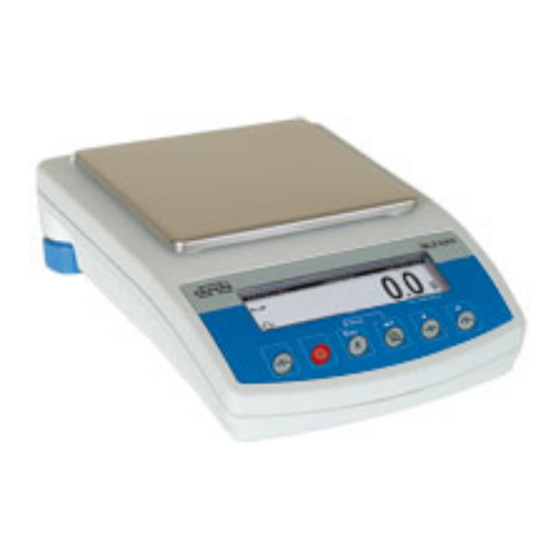
Table of Contents
Advertisement
Manual number
PTI-12-03/01/07/A
Integrated system for counting pieces and labelling
WLT/L series
WLL series
MANUFACTURER OF ELECTRONIC WEIGHING INSTRUMENTS
RADWAG, 26 – 600 Radom, Bracka 28 Street
POLAND
phone +48 48 38 48 800, phone/fax. +48 48 385 00 10
Sales Department +48 48 366 80 06
www.radwag.com
Advertisement
Table of Contents

Summarization of Contents
GETTING STARTED
Conditions of appropriate use
Specifies environmental and placement requirements for accurate weighing.
Time of warming-up
Details the necessary warm-up period for stable measurements.
BALANCE DESCRIPTION
Graphic display
Explains the elements and symbols shown on the balance display.
Balance keyboard
Describes the functions of each key on the balance.
PC keyboard
Lists PC keyboard functions for balance operation and database management.
Connecting sockets
Identifies and describes the purpose of each connection port on the balance.
USER MENU
P1 Calibration
Details the procedures for calibrating the balance.
P2 GLP
Configures settings related to Good Laboratory Practice (GLP) printouts.
P3 Date/Time
Allows setting the balance's internal clock and date format.
P4 Reading
Adjusts parameters affecting display refresh and filtering.
P5 RS-232
Configures serial communication parameters for RS-232 interface.
P6 Printouts
Customizes settings for various types of printouts.
P7 Units
Selects and enables available measurement units.
P8 Operating modes
Defines which operating modes are accessible during use.
P9 Other
Configures miscellaneous settings like language and backlight.
WEIGHING OPERATIONS
Tarring
Explains how to zero the balance with a load on the pan.
Inscribing Tare Value
Describes how to manually enter a tare value.
Automatic Tare
Details the function for automatically setting tare values.
Zeroing
Explains the process of zeroing the balance.
Setting Work Parameters
Filter Setting
Adjusts the filter to compensate for environmental conditions.
Median Filter Setting
Configures the median filter to eliminate large disturbances.
Display Refresh Time Setting
Controls how often the display updates with new readings.
Autozero Operation Setting
Enables automatic zero point correction for stable readings.
Last Digit Display
Determines when the last digit of the displayed value is shown.
Negative Display
Allows changing the display to a negative effect.
Two Platforms
Enables simultaneous display of readings from two platforms.
Automatic Tare
Details the function for automatically setting tare values.
Other Balance Parameters
Reception Settings
Manages reception of balance parameters via RS 232.
Password Setup
Sets a password to restrict menu access.
Barcode Scanner Configuration
Configures settings for barcode scanner use.
Counting Pieces Function
Databases
Manages various databases for counting operations.
Operator Database Management
Details how to manage operator entries in the database.
Label Database Management
Explains how to manage label designs and printout variables.
Assortment Database Management
Describes management of article details for counting.
Contractor Database Management
Explains how to manage contractor information.
Operating Settings
Defines the balance's operational behavior in counting mode.
Configuration Settings
Sets up various parameters for the counting function.
Printer Settings
Configures printer-specific options for counting mode.
Counting Pieces Mode Details
Display Overview
Explains the display elements during counting operations.
Reference Mass Setup
Details how to set the reference mass for counting.
Setting Single Piece Mass
Guides on entering the weight of a single item.
Determining Reference Mass by Sample
Explains how to determine reference mass by weighing a sample quantity.
Importing Item Mass from Database
Describes importing item mass from the database.
Saving Reference Mass to Memory
Explains how to save single piece mass to the assortment base.
Counting Pieces with Checkweighing
Explains how to use counting with result control.
Labelling Procedure
Quick Database Search
Describes how to quickly search within databases.
Quick Assortment Search
Details methods for searching the assortment database.
Operator Selection and Login
Explains how to select an operator and log into the system.
Article Selection
Describes how to choose an article from the database.
Contractor Selection
Explains how to select a contractor from the database.
Resetting Counters and Variables
Details how to reset counting variables and counters.
Regular Labelling
Cumulative Label Printing
Explains how to print cumulative labels summarizing single labels.
Barcodes Overview
General Description
Introduces barcodes, their application, and benefits.
EAN Code Types
Describes the EAN barcode types and structure.
Other Types
Briefly explains Code 39, Code 128, and Interleaved 2 of 5.
Usage Advantages
Lists the benefits of employing barcode technology.
EAN-128 Usage in Scales
Details the application of EAN-128 standard with AI.
Barcode Scanner Operation
Explains how to use barcode scanners with the balance.
Statistics Functionality
Function Activation
Details the steps to activate the statistics function.
Printout Options
Standard Printout
Explains the default printout format.
Non-Standard Printouts
Guides on creating and configuring custom printouts.
Inscribing Custom Text
Details how to input custom text into printouts.
Selecting Non-Standard Printouts
Explains how to select between standard and custom printouts.
EPSON Polish Character Set
Describes how to set Polish characters for EPSON printers.
Printer and Computer Cooperation
Connection Cable Diagrams
Provides diagrams for connecting cables to devices.
Transmission Protocol
Basic Information
Provides fundamental information about the communication protocol.
Parameters
Lists and explains serial communication settings.
Characteristics
Describes the two methods of data transmission.
Continuous/Automatic Printout
Explains automatic data transmission features.
Automatic Printout Types
Details the three types of automatic printouts available.
Continuous Transmission
Describes how continuous data transmission works.
Continuous Transmission with Pauses
Explains continuous transmission with user-defined pauses.
Stable Result Transmission
Details transmission of results only when they are stable.
Automatic Printout Survey
Summarizes the different types of automatic printouts.
Command/Response Syntax
Explains the syntax for commands and responses.
Command Syntax
Details the structure and format of commands.
Response Syntax
Explains the structure and meaning of responses.
Computer-to-Balance Commands
Lists commands for computer-to-balance communication.
Technical Parameters
WLT/L Series
Lists technical parameters for the WLT/L series scales.
WLL Series
Lists technical parameters for the WLL series scales.
Appendix A: Barcode Scanner Programming
Scanner Barcode Reading Setup
Details how to set the barcode reading type.
















Need help?
Do you have a question about the WLL 10/A2 and is the answer not in the manual?
Questions and answers